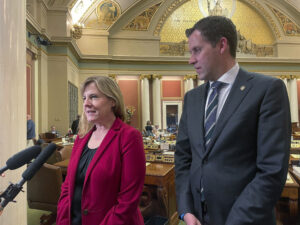Why Barack Is Behind
Among the very puzzling aspects of the midterm election -- and the Democratic debacle that appears to be looming in November -- is why voters would return the opposition to power only two years after the multiple disasters of the Bush administration.
Among the very puzzling aspects of the midterm election — and the Democratic debacle that appears to be looming in November — is why voters would return the opposition to power only two years after the multiple disasters of the Bush administration. They know that the years of Republican dominance in Washington led to an extremely expensive war that was launched on false pretenses; to enormous deficits, skewed tax cuts and unrestrained waste; and, by the end, to a ruined economy.
Most Americans feel no nostalgia for that era or its politicians. A midsummer Newsweek poll showed that the Republican right’s program is still far from popular. Asked whether they care more about reducing the federal budget deficit or increasing federal spending to create jobs, 57 percent said they wanted more spending, not less, and only 37 percent were more concerned about red ink. More than half want to let the George W. Bush tax cuts benefiting the top 2 percent expire, and only 38 percent prefer to extend them. Nearly every poll indicates that even now, as President Obama’s approval ratings sink, those of his predecessor remain considerably lower.
Yet we appear to be heading toward an election that will empower an ideological minority, whose candidates endorse extremist nostrums such as privatizing Social Security and shutting down the Environmental Protection Agency. Why should this be happening now?
There are several plausible explanations, but the most persuasive overall is what political scientists and pollsters describe as the “enthusiasm gap.” The zeal that Democrats felt in 2006 when they ousted the corrupt Tom DeLay machine, and in 2008, when they bade farewell to Bush and Dick Cheney, has dissipated under Barack Obama — who has inspired the same kind of fiery determination among Republicans. In a midterm election, when voter turnout is predictably much lower than in a presidential contest, the fervor of the partisan base can make the difference between a draw and a rout.
Public Policy Polling, a firm whose accuracy was recognized by The Wall Street Journal despite its Democratic affinities, recently tried to measure the enthusiasm gap in several statewide contests. Across the country, its researchers found that that gap has shifted an average of 7 points in each of 10 Senate and gubernatorial races — and in some places, such as the president’s home state of Illinois, that number is even higher. Without the gap, critical Senate races, and presumably many House races as well, would be closer — or the Democrats would be leading.
Although President Obama has passed important reform legislation, saved the auto industry and confirmed two Supreme Court nominees, both women, the Democratic base is obviously dispirited. They hoped he would bring more fundamental change. Instead, his White House staff seizes every opportunity to exacerbate the inevitable letdown by insulting, bullying and mocking the progressive voters who are the most vital and loyal constituents of his coalition.
At this late hour, Obama shows few signs of understanding why he is about to lose the majorities that made his achievements possible. He needs to speak up, fight back and win back the respect of the public. They know that if he won’t fight for his party and his program, he won’t fight for them, either.
Joe Conason writes for the New York Observer.
© 2010 Creators.com
Your support matters…Independent journalism is under threat and overshadowed by heavily funded mainstream media.
You can help level the playing field. Become a member.
Your tax-deductible contribution keeps us digging beneath the headlines to give you thought-provoking, investigative reporting and analysis that unearths what's really happening- without compromise.
Give today to support our courageous, independent journalists.






You need to be a supporter to comment.
There are currently no responses to this article.
Be the first to respond.